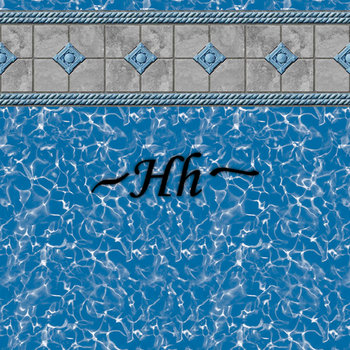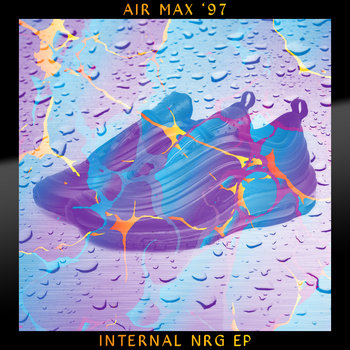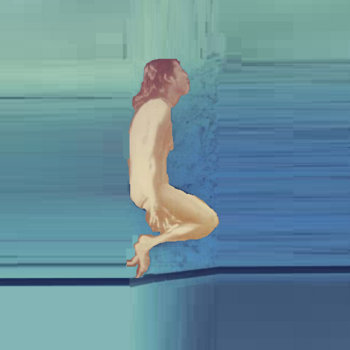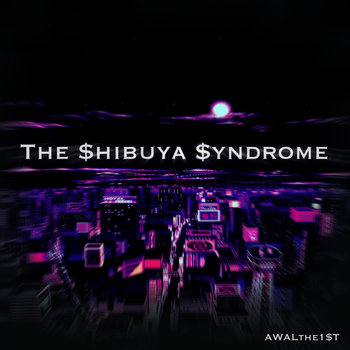In my recent
Dummy article taking a second look at vaporwave (click here to see it) I wrote
there has been some confusion between vaporwave, hypnagogic pop and chillwave. OK I'm sorry, I know that there's a special place in hell for people who, like me, constantly strive to maintain a separation between vaporwave, hypnagogic pop and chillwave - it's a back room where Satan forever explains the differences between death metal, black metal and doom metal. But vaporwave and its sibling genres each had different beginnings, different artists and different approaches when they were first identified, before they were blurred together by writers, fans and artists unable to tell the difference between the three.
So I thought that I would outline some of the differences that have been made in the past between the three - just for the record, just for anyone that wants to know. Clearly they are all part of the same family of styles, but there are, or at least have been, stylistic and contextual differences between them. Please note: I am abundantly aware that most people, musicians, fans and bystanders alike, might not give two shits about these differences. Nor should they. Or the history, for that matter. People can and will use these terms however they want to - I am no-one to stop them, and I wouldn't want to.
No one appreciates more than me that 'in the end it's all music.' No one appreciates more than me that genres are imaginary constructions. But at their most historically differentiated, this is how the three terms / constructions stand. If this is all ridiculous to you, so be it, it's pretty ridiculous to me too. And to me, this is less about being a 'hipster' (lol hipsters lol omg haha let's move on) than about surveying the landscape of underground new music in the detail it deserves.
Nor, indeed, is this account definitive, of course. If I am wrong or missing something about the history, let me know and I'll make edits to this page. And please feel free to debate anything and everything in the comments.
Note that although the terms have regularly been blurred together in articles and blog posts for four years now, a decisive factor today comes from Bandcamp tags, which are (like it or not) heavily promoting the genre-identification of music, since they're a way to get new releases noticed by the right people. Usually, the genre tags are multiple, and a great many artists use both the 'chillwave' and 'vaporwave' tags at the same time, often more as well.
Chillwave
Probably the most well-known term today, 'chillwave' was identified and described by Carles, the author of the widely-read Hipster Runoff blog, in
a post on July 27 2009 (click here to read). Referring to new acts Washed Out, Neon Indian and Memory Cassette / Memory Tapes, he says:
Feels like 'chill wave' is dominated by 'thick/chill synths'... Feel like chillwave is supposed to sound like something that was playing in the background of 'an old VHS cassette that u found in ur attic from the late 80s/early 90s.'
Carles is writing within, referring to and situating 'chill wave' in relation to the indie community and its traditions, mentioning Animal Collective, Pitchfork and Gorilla vs Bear. It should be noted that the blog is predominantly satirical in nature, but actually I don't read the post as 100% sarcastic or nonsensical. Clearly tongue in cheek to varying degrees in various parts? Yes absolutely. A complete falsehood both in intention and effect? No. There will of course be disagreement on this. Carles went on to mention chillwave a number of times, adding Toro Y Moi to the genre, which made a lot of sense musically.
Subsequently, the meaning of the term mutated as it was passed around. For many, most prominently Simon Reynolds, chillwave was a general term that referred to a number of lo-fi indie / underground musicians exploring 80s pop styles who could have been seen as following or influenced by Ariel Pink (
I have disputed this interpretation here, preferring to talk about an 'Altered Zones Generation'). Chillwave arguably still carries connotations of prominent indie musicians with an easy-going, relaxing retro style. But now that it's become closely associated with vaporwave, chillwave's connotations of technology that was cutting-edge (and pretty yuppy) in the 80s but that are charmingly lo-fi and kitsch now are heavier than ever (remember, interest in and attachment to kitsch doesn't automatically imply insincerity, irony, satire, mockery or bad music). But in the beginning at least, chillwave was a lot more poppy, whereas vaporwave is a more raw / hardcore approach with a much more specific and developed visual / conceptual / extra-sonic world. Since Carles's chillwave resonated so well with a particular hipster stereotype that was popular at the time, it's unsurprising that Washed Out's track 'Feel it All Around,' the mp3 attached to Carles's original post, became the theme tune to the comedy series
Portlandia.
Hypnagogic Pop
Appearing at almost the exact same time as Carles's chillwave post, 'Hypnagogic Pop' was described by David Keenan in an article published in the August 2009 issue of Wire Magazine (#306). It mentions The Skaters and its constituent parts James Ferraro (this long before he was well-known and hi-fi) and Spencer Clark, Pocahaunted, Zola Jesus, the Shdwply label, Emeralds and more. The article is a great read, with some wonderfully expressed images and insights, and
can be read by clicking here - I don't endorse the comments made below it though. Keenan, the Wire and the artists discussed in the article are generally speaking in a more underground and experimental place than the artists associated with chillwave. This distinction is borne out in the music described, which typically has clearly more exaggerated lo-fi qualities than what was in the same month called chillwave, and a more free-form experimental feel.
Taking its name from the hallucinatory state between being asleep and being awake, Keenan gave a rich and full description of its stylistic characteristics and prevalence that can't be reduced to any one quotation so do read the original, but to pick out some key parts:
Hypnagogic pop is pop music refracted through the memory of a memory. It draws its power from the 1980s pop culture into which many of the genre's players were born, and which is only now being factored into underground music as a spectral influence... Hypnagogic pop is 1980s-inspired psychedelia... it homes in on the futuristic signifiers of the 1980s.
Although aesthetically and thematically there is considerable overlap between chillwave and hypnagogic pop (and, indeed, hauntology), it should nevertheless be noted that the cultural contexts of each original statement on the genres, together with the artists described therein, are different. Moreover, to my ears at least, the differences in sounds between each group of artists are also pretty audible. However, as the terms passed into the underground new music discourse, they understandably blurred together.
Vaporwave
As far as I know, this term started life in
a blogpost of October 13, 2011, describing 'Surfs Pure Hearts' by Girlhood. I would have identified the sound of this release as squarely within hypnagogic pop, but of course that's just me, and it seems quite possible that the post's author wasn't familiar with that category. Then when I was researching for
the first part of my article on 'the virtual plaza,' I found the term 'vaporwave' as one of a number of Last.fm tags attached to the music in question. I showed Robin Burnett (i.e. INTERNET CLUB etc) the set of tags and they liked that one best. In the article, I explored my own sense of the term's connotations ('vaporware,' and a Marx quote that 'vapor' reminded me of, 'all that is solid melts into air') and quoted Robin Burnett and Vektroid's reactions to it too.
It should be noted that much of the descriptive language in my article was aimed at 'the virtual plaza,' which included not just vaporwave but a bunch of rather different artists surrounding Dis magazine, Hippos in Tanks and UNO NYC as well. However, since the first part of the article, on vaporwave, was far, far more widely read than the second part on the Dis, HIT, UNONYC artists, and since it began with an introduction to the virtual plaza as a whole, the associations with vaporwave might have been skewed for readers more towards the cynical and dystopian music of the second part. As a sub-category of / differentiation within 'the virtual plaza,' then, I described vaporwave as:
a next step in the evolution of hypnagogic pop... the typical vaporwave track is a wholly synthesised or heavily processed chunk of corporate mood music, bright and earnest or slow and sultry, often beautiful, either looped out of sync and beyond the point of functionality or standing alone, and sometimes with a smattering of miasma about it. It’s made by mysterious and often nameless entities that lurk the internet, often behind a pseudo-corporate name or web façade, and whose music is typically free to download through Mediafire, Last FM, Soundcloud or Bandcamp... The typical vaporwave zip file (album, if you like) presents itself as a collection of inspiringly modern, motivational and mood-regulating settings – perfect for that infomercial, that menu screen, that in-flight safety video, that business park promotional video, that drinks reception in the lobby.
The bulk of my description of the term was focused on its similarities and differences with hypnagogic pop. My use of the term 'vaporwave' reflected how I saw it as something new and different from hypnagogic pop (even though it was on a continuum with it), something with a more modern, hi-fi sound often favouring e-piano and crystal chimes and a sample-based approach. It's clearer to me now that the vaporwave community were using the term to describe something a lot more synonymous with Keenan's hypnagogic pop (again, those people could well have been less familiar with the latter term). My reaction to the term's use in the article was complex, but for many of the artists, 'vaporwave' was simply a reference to a perception of fogginess and cloudiness in the music (and I quoted Burnett on this).
For me, the unique departure that I saw as 'vaporwave' (i.e. the stuff that distinguishes it from the other genre categories above and below) begins with
NEW DREAMS LTD. by LASERDISC VISIONS in July 2011 (I am less sure of the INTERNET CLUB chronology, but for me it also has this quality). I stand by this.
EDIT: Robin Burnett tweeted this:
@RougesFoam w/r/t to chronology: a year or so ago vek said she considered a record me and @Leonce made back in january of 2011 called Vector Tables (http://datavision.bandcamp.com/) heavily influential towards New Dreams Ltd.—VT in turn i'd say was influenced by Games' SPEND THE NIGHT WITH GAMES mixtape and Lopatin's Eccojams, although with the hindsight of two and a half years it's fair to say VT (especially the second and last tracks) took from the wreckage of hypnagogic pop in general, and i guess just an observation that r&b and 80s ads sounded great slowed down—even before VT though, vektroid's TELNET EROTIKA record from late 2010 was on this same exact wavelength, but produced much better, haha. I suppose just me and vek were just doing the same sorts of things at the same time, but we didn't know it until like, mid 2011.
@RougesFoam INTERNET CLUB itself started as a bit of a turntable.fm-based joke to make purposely ridiculous nonsense
@RougesFoam but it changed tack after Leonce turned me on to Computer Dreams in july 2011
However, in the past year it has become a lot clearer that the most influential album by that artist is
FLORAL SHOPPE by MACINTOSH PLUS, released December 2011. I had placed less emphasis on this album in my article because I associated that album more with hypnagogic pop, screwing and echo jams, and less squarely with 'the virtual plaza.' Given the average sound of stuff tagged vaporwave today, for the bulk of fans at least 'FLORAL SHOPPE' seems to be the definitive vaporwave album (and
the November 2012 Needle Drop review of the album, currently at 28,000 views, is probably highly responsible for this - I for one was a little disappointed in that review, its generalisations and its cynical parts, and hope that people haven't been putting my article(s) in the same boat with it - I fear they might have, but que sera).
(It's also worth noting that vaporwave producers are very often, I think, younger than the chillwavers and hypnagogic pop artists, the latter being now generally in their mid / late twenties.)
Other articles had their own definitions, probably influenced to varying extents by what had come before:
Leor Galil for Chicago Reader (February 19, 2013):
Vaporwave... is sample based, layering and warping pieces of the most reviled forms of music in the recording era: chintzy 80s lounge, smooth jazz, Muzak. Sometimes producers slow down and layer samples till they sound like velvety R&B slow jams, or chop and repeat them to create a sort of languid stutter. Its dreamlike feel recalls the hypnagogic pop of multiply pseudonymous New York musician and producer James Ferraro.
Michelle Lhooq for Thump (June 25, 2013):
Imagine taking bits of 80's Muzak, late-night infomercials, smooth jazz, and that tinny tune receptionists play when they put you on hold, then chopping that up, pitching it down, and scrambling it to the point where you’ve got saxophone goo dripping out of a cheap plastic valve. That’s vaporwave.
Today there is some internal tension over a subcategory / degradation of vaporwave going by the term 'broporwave.' See my
second essay on vaporwave for more on this. Many of the artists involved have appropriated this term with tongue-in-cheek but ultimately fond connotations (good for them). To whatever extent broporwave is something distinct from vaporwave, it's clear that much of what is being discussed as or tagged as vaporwave today is heavily to do with retro, technostalgic kitsch and 80s smooth-jam pop music (remember, interest in and attachment to kitsch doesn't automatically imply insincerity, irony, satire, mockery or bad music), bringing it a little closer, spiritually, to hypnagogic pop and chillwave than I initially saw it as being. Of course, it is not for me, or Fantano, or Galil, or Lhooq, to say definitively what vaporwave 'is.' It is for you and the underground new music community to decide. (Or of course, you may take none of these terms seriously in the first place).
EDIT: See also: interviews of Ailanthus Recordings and some of the artists on it: Part 1 - The Head of Ailanthus and Part 2 - 회사AUTO.
UPDATE: Liz, the co-founder of SPF420, said this in
a Dummy article on New Generation:
"Vaporwave, in my opinion, is our current 'punk scene'. The digital rebels. The ones who 'steal' others' music, just to manipulate it and chop it up a bit. That is so fucking punk...It's like how punk bands only knew how to play power chords. It's brilliant. Vaporwave isn't lazy, and neither is punk. I think that these two genres of music are parallel: short tracks with messages that are very literal, made with minimal intent (for the most part)."
The writer of the article, Russell Thomas, concluded:
New Generation, its associates and sister-collectives, consist of a marginalised set of up-and-coming music-makers who make being the natural underdog seem cooler and more rewarding than ever before - this movement speaks of a more connected world, with embryonic punk spirit living in each sampled track, cover and remix.
Also: Glo-Fi
Glo-Fi was a term gently pushed by Pitchfork that
they first started using, amazingly enough, in late July 2009 as well, within the same like two weeks 'chillwave' and 'hypnagogic pop' were coined. Perhaps the music in question here is even lighter, more guitarry and even more typically indie than Washed Out etc, but it's kind of besides the point, ultimately because you rarely see the term used nowadays - it lost out to the others, and it's so similar to them, just less specific / useful.
Also: Hauntology
This is definitely part of the same broad historical genus as the others, but it's at a significant remove from them in terms of time, space and culture. While the term is usually associated with Derrida's coinage of the word in
Specters of Marx (and
I have written my own, more general and abstract interpretation of the aesthetic) in most cases it implies the work of a generation of musicians who grew up in the 60s, 70s or 80s, generally British, exploring music from the mid-twentieth century (typically 60s BBC music) using various techniques of estrangement. The category was described and developed by Mark Fisher and Simon Reynolds in late 2005 and 2006. Lots of the stuff that's seen to be quintessential hauntology, such as the stuff by The Caretaker, is deeply comparable to vaporwave. The creative process is very similar, but the cultural contexts and source material is very different. And actually, I've always seen hauntology as darker, more tragically ironic.
Also: Echo Jams / Ecco Jams
It was Daniel Lopatin's sideline in what came to be called echo jams that, it seems, provided the initial spark of influence that led to vaporwave. Vaporwave artists have counted Lopatin's
Chuck Person's Eccojams Vol. 1 (2010) as a key influence. Lopatin's track 'Nobody Here' was also hugely popular in the underground. To me, echo jams is proto-vaporwave - looping and often screwing the sweetest bits of late eighties adult contemporary pop, before the distinguishing interest in more modern, hi-tech corporate sounds took hold. The early stuff by Computer Dreams, 骨架的, esc 不在 etc. is very much cut from this cloth. Now, this technique is so prevalent in what's now being discussed and tagged as vaporwave that they're practically the same category.













































